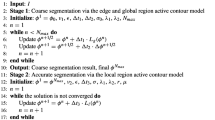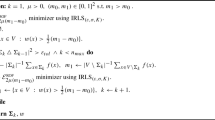Abstract
This paper introduces a novel image segmentation technique that is inspired by social influence and opinion dynamics, establishing an association between social sciences and image analysis. This methodology analogizes each pixel in an image to an individual within a population, where the intensity of the pixel reflects an individual’s opinion. By simulating social influence through iterative interactions among individual pixels, our approach emulates the interaction patterns observed in human populations. During each interaction, a pixel selects another pixel within its immediate neighborhood to compare opinions or intensity levels. If the intensities are similar, indicative of analogous opinions, we adjust their values to minimize the difference, thereby producing the formation of homogenous regions within the image. Conversely, when the intensity difference between the two pixels is significant, we manipulate the intensity of both pixels to accentuate this disparity and effectively segregate the regions within the image. After several iterations, the objects in the image tended to split according to the homogeneity of their intensities. The efficacy of the proposed technique was tested using several images and widely accepted quality metrics. The results of these experiments show that the proposed method achieves competitive performance compared to other segmentation techniques.













Similar content being viewed by others
Data availability
The dataset used in this study is available: https://www2.eecs.berkeley.edu/Research/Projects/CS/vision/bsds/
References
Lazer, D., Pentland, A., Adamic, L., Aral, S., Barabási, A. L., Brewer, D., & Van Alstyne, M. (2009). Computational social science. Science, 323(5915), 721–723.
Cioffi-Revilla, C. (2014). Introduction to computational social science. London: Springer. https://doi.org/10.1007/978-1-4471-5661-1
Edelmann, A., Wolff, T., Montagne, D., & Bail, C. A. (2020). Computational social science and sociology. Annual Review of Sociology, 46, 61–81.
Holme, P., & Liljeros, F. (2015). Mechanistic models in computational social science. Frontiers in Physics. https://doi.org/10.3389/fphy.2015.00078
Cuevas, E. (2020). An agent-based model to evaluate the COVID-19 transmission risks in facilities. Computers in Biology and Medicine, 121, 103827.
Xu, F., Li, Y., Jin, D., Lu, J., & Song, C. (2021). Emergence of urban growth patterns from human mobility behavior. Nature Computational Science, 1(12), 791–800.
Alves, M. A., & Cordeiro, R. L. (2021). Effective and unburdensome forecast of highway traffic flow with adaptive computing. Knowledge-Based Systems, 212, 106603.
Geers, G., Sester, M., Winter, S., & Wolfson, O. E. (2014). Social Issues in Computational Transportation Science (Dagstuhl Seminar 13512).
Alassad, M., Spann, B., Al-khateeb, S., & Agarwal, N. (2021). Using computational social science techniques to identify coordinated cyber threats to smart city networks. Design and construction of smart cities: toward sustainable community (pp. 316–326). Berlin: Springer International Publishing.
Moussaïd, M., Kämmer, J. E., Analytis, P. P., & Neth, H. (2013). Social influence and the collective dynamics of opinion formation. PLoS ONE, 8(11), e78433.
Smaldino, P. (2023). Modeling social behavior: Mathematical and agent-based models of social dynamics and cultural evolution. Princeton: Princeton University Press.
Granovetter, M. (1978). Threshold models of collective behavior. American Journal of Sociology, 83(6), 1420–1443.
Macy, M. W., & Evtushenko, A. (2020). Threshold models of collective behavior ii: the predictability paradox and spontaneous instigation. Sociological Science, 7(26), 628–648.
Chen, X., Zhang, X., Xie, Y., & Li, W. (2017). Opinion dynamics of social-similarity-based Hegselmann-Krause model. Complexity, 2017(1), 1820257.
Luo, Y., Li, Y., Sun, C., & Cheng, C. (2022). Adapted Deffuant-Weisbuch model with implicit and explicit opinions. Physica A: Statistical Mechanics and its Applications, 596, 127095.
Zhou, Q., & Wu, Z. (2022). Multidimensional Friedkin-Johnsen model with increasing stubbornness in social networks. Information Sciences, 600, 170–188.
Radillo-Díaz, A., Pérez, L. A., & del Castillo-Mussot, M. (2009). Axelrod models of social influence with cultural repulsion. Physical Review E—Statistical, Nonlinear, and Soft Matter Physics, 80(6), 066107.
Meyer, P. G., & Metzler, R. (2024). Time scales in the dynamics of political opinions and the voter model. New Journal of Physics, 26(2), 023040.
Slanina, F., & Lavicka, H. (2003). Analytical results for the Sznajd model of opinion formation. The European Physical Journal B-Condensed Matter and Complex Systems, 35, 279–288.
Javarone, M. A. (2014). Social influences in opinion dynamics: the role of conformity. Physica A: Statistical Mechanics and its Applications, 414, 19–30.
Colaiori, F., & Castellano, C. (2015). Interplay between media and social influence in the collective behavior of opinion dynamics. Physical Review E, 92(4), 042815.
Hu, H. B., & Wang, X. F. (2009). Discrete opinion dynamics on networks based on social influence. Journal of Physics A: Mathematical and Theoretical, 42(22), 225005.
Carpentras, D., Maher, P. J., O’Reilly, C., & Quayle, M. (2022). Deriving an opinion dynamics model from experimental data. Journal of Artificial Societies & Social Simulation. https://doi.org/10.18564/jasss.4947
Wu, Q., & Castleman, K. R. (2023). Image segmentation. Microscope image processing (pp. 119–152). Cambridge: Academic Press.
Kaur, D., & Kaur, Y. (2014). Various image segmentation techniques: a review. International Journal of Computer Science and Mobile Computing, 3(5), 809–814.
Bhargavi, K., & Jyothi, S. (2014). A survey on threshold based segmentation technique in image processing. International Journal of Innovative Research and Development, 3(12), 234–239.
Ma, J., He, Y., Li, F., Han, L., You, C., & Wang, B. (2024). Segment anything in medical images. Nature Communications, 15(1), 654.
Gelasca, E. D., Byun, J., Obara, B., & Manjunath, B. S. (2008). Evaluation and benchmark for biological image segmentation. In: 2008 15th IEEE international conference on image processing (pp. 1816–1819). IEEE.
Chen, C., Wang, C., Liu, B., He, C., Cong, L., & Wan, S. (2023). Edge intelligence empowered vehicle detection and image segmentation for autonomous vehicles. IEEE Transactions on Intelligent Transportation Systems. https://doi.org/10.1109/TITS.2022.3232153
Ko, T. Y., & Lee, S. H. (2020). Novel method of semantic segmentation applicable to augmented reality. Sensors, 20(6), 1737.
Vairalkar, M. K., & Nimbhorkar, S. U. (2012). Edge detection of images using Sobel operator. International Journal of Emerging Technology and Advanced Engineering, 2(1), 291–293.
Rahmawati, S., Devita, R., Zain, R. H., Rianti, E., Lubis, N., & Wanto, A. (2021). Prewitt and canny methods on inversion image edge detection: an evaluation. In Journal of Physics: Conference Series, 1933(1), 012039.
Radhakrishnan, M., Panneerselvam, A., & Nachimuthu, N. (2020). Canny edge detection model in MRI image segmentation using optimized parameter tuning method. Intelligent Automation Soft Computing, 26(4), 1185–1199.
Ding, K., Xiao, L., & Weng, G. (2017). Active contours driven by region-scalable fitting and optimized Laplacian of Gaussian energy for image segmentation. Signal Processing, 134, 224–233.
McIlhagga, W. (2011). The canny edge detector revisited. International Journal of Computer Vision, 91, 251–261.
Cui, W., Guan, Z., & Zhang, Z. (2008). An improved region growing algorithm for image segmentation. In: 2008 international conference on computer science and software engineering (Vol. 6, pp. 93–96). IEEE.
Khoulqi, I., & Idrissi, N. (2023). Split and merge-based breast cancer segmentation and classification. Research anthology on medical informatics in breast and cervical cancer (pp. 139–153). Hershey: IGI Global.
Pare, S., Kumar, A., Singh, G. K., & Bajaj, V. (2020). Image segmentation using multilevel thresholding: a research review. Iranian Journal of Science and Technology, Transactions of Electrical Engineering, 44, 1–29.
Bindu, C. H., & Prasad, K. S. (2012). An efficient medical image segmentation using conventional OTSU method. International Journal of Advanced Science and Technology, 38(1), 67–74.
Sultana, F., Sufian, A., & Dutta, P. (2020). Evolution of image segmentation using deep convolutional neural network: a survey. Knowledge-Based Systems, 201, 106062.
Dhanachandra, N., Manglem, K., & Chanu, Y. J. (2015). Image segmentation using K-means clustering algorithm and subtractive clustering algorithm. Procedia Computer Science, 54, 764–771.
Oliva, D., Abd Elaziz, M., Hinojosa, S., Oliva, D., Abd Elaziz, M., & Hinojosa, S. (2019). Multilevel thresholding for image segmentation based on metaheuristic algorithms. Metaheuristic Algorithms for Image Segmentation: Theory and Applications (pp. 59–69). Berlin: Springer.
Li, H., Cai, J., Nguyen, T. N. A., & Zheng, J. (2013, July). A benchmark for semantic image segmentation. In 2013 IEEE International Conference on Multimedia and Expo (ICME) (pp. 1–6). IEEE.
Lei, T., Jia, X., Zhang, Y., He, L., Meng, H., & Nandi, A. K. (2018). Significantly fast and robust Fuzzy C-means clustering algorithm based on morphological reconstruction and membership filtering. IEEE Transactions On Fuzzy Systems, 26(5), 3027–3041.
Ayala, E., Cuevas, E., Zaldívar, D., & Pérez, M. (2023). Image segmentation by agent-based pixel homogenization. IEEE Access. https://doi.org/10.1109/ACCESS.2023.3276721
Mittal, H., & Saraswat, M. (2018). An optimum multi-level image thresholding segmentation using non-local means 2D histogram and exponential Kbest gravitational search algorithm. Engineering Applications of Artificial Intelligence, 71, 226–235.
Oliva, D., Cuevas, E., Pajares, G., Zaldivar, D., & Osuna, V. (2014). A multilevel thresholding algorithm using electromagnetism optimization. Neurocomputing, 139, 357–381.
Choy, S. K., Ng, T. C., & Yu, C. (2020). Unsupervised fuzzy model-based image segmentation. Signal Processing, 171, 107483.
DhanachandraChanu, N. Y. J. (2020). An image segmentation approach based on fuzzy c-means and dynamic particle swarm optimization algorithm. Multimed Tools and Applications. https://doi.org/10.1007/s11042-020-08699-8
Chengmao, Wu., & Chen, Y. (2020). Adaptive entropy weighted picture fuzzy clustering algorithm with spatial information for image segmentation. Applied Soft Computing, 86, 105888.
Hernandez del Rio, A. A., Cuevas, E., & Zaldivar, D. (2020). Multi-level image thresholding segmentation using 2D histogram non-local means and metaheuristics algorithms. In D. Oliva & S. Hinojosa (Eds.), Applications of hybrid metaheuristic algorithms for image processing studies in computational intelligence. Berlin: Springer.
Vinoth Kumar, B., Sabareeswaran, S., & Madumitha, G. (2020). A decennary survey on artificial intelligence methods for image segmentation. In R. Venkata Rao & J. Taler (Eds.), Advanced engineering optimization through intelligent techniques advances in intelligent systems and computing. Berlin: Springer.
Chouksey, M., Jha, R. K., & Sharma, R. (2020). A fast technique for image segmentation based on two Meta-heuristic algorithms. Multimed Tools Applications. https://doi.org/10.1007/s11042-019-08138-3
Author information
Authors and Affiliations
Corresponding author
Ethics declarations
Conflict of interest
None of the authors of this paper has a financial or personal relationship with other people or organizations that could inappropriately influence or bias the content of the paper. It is to specifically state that “No Competing interests are at stake and there is No Conflict of Interest” with other people or organizations that could inappropriately influence or bias the content of the paper.
Additional information
Publisher's Note
Springer Nature remains neutral with regard to jurisdictional claims in published maps and institutional affiliations.
Rights and permissions
Springer Nature or its licensor (e.g. a society or other partner) holds exclusive rights to this article under a publishing agreement with the author(s) or other rightsholder(s); author self-archiving of the accepted manuscript version of this article is solely governed by the terms of such publishing agreement and applicable law.
About this article
Cite this article
Cuevas, E., Luque, A., Vega, F. et al. Social influence dynamics for image segmentation: a novel pixel interaction approach. J Comput Soc Sc 7, 2613–2642 (2024). https://doi.org/10.1007/s42001-024-00315-1
Received:
Accepted:
Published:
Issue Date:
DOI: https://doi.org/10.1007/s42001-024-00315-1




